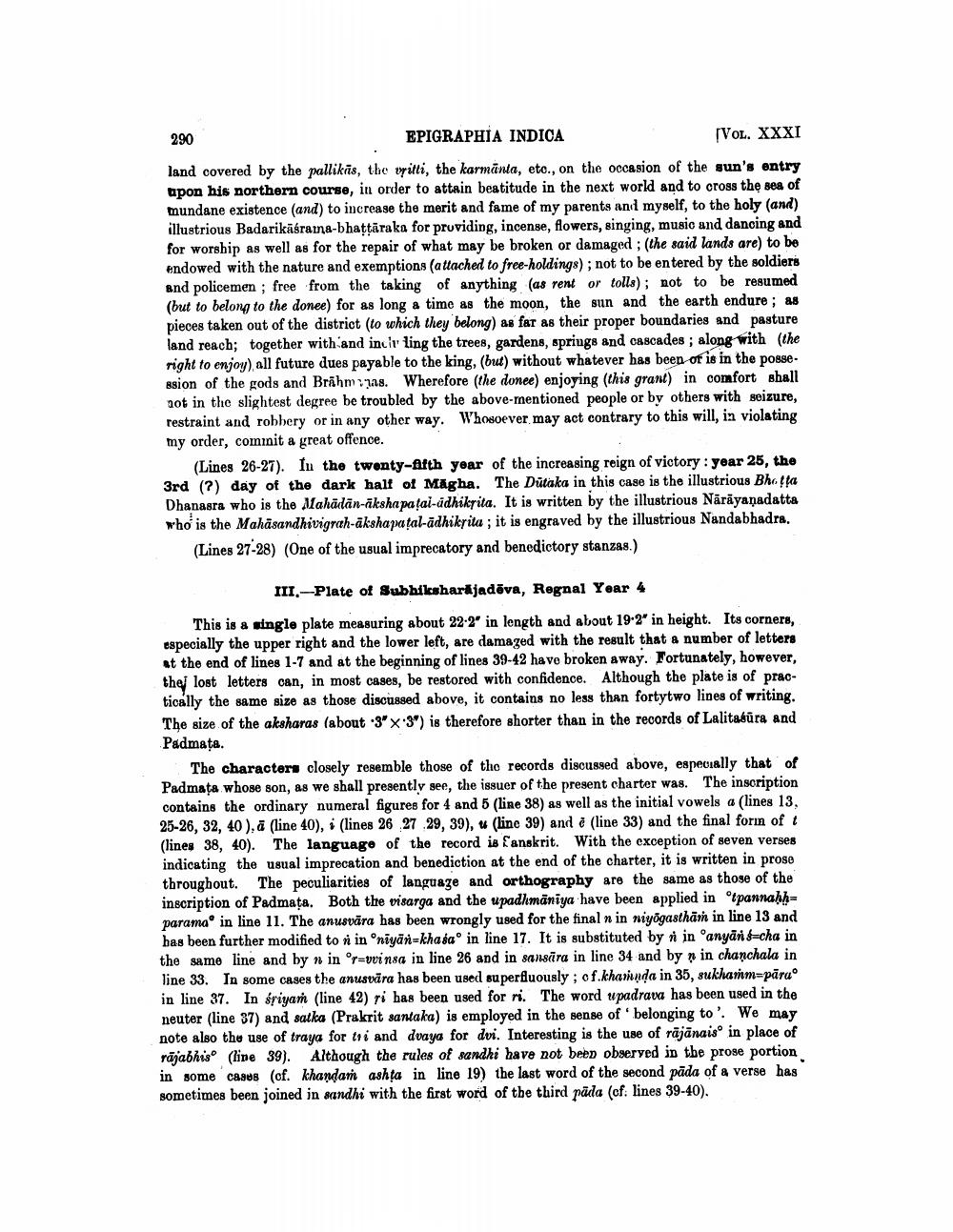________________
290
EPIGRAPHIA INDICA
VOL. XXXI
land covered by the pallikās, the writti, the karmanta, etc., on the occasion of the sun's entry upon his northern course, in order to attain beatitude in the next world and to cross the sea of mundane existence (and) to increase the merit and fame of my parents and myself, to the holy (and) illustrious Badarikāśraina-bhattāraka for pruviding, incense, flowers, singing, music and dancing and for worship as well as for the repair of what may be broken or damaged: (the said lands are) to be endowed with the nature and exemptions (attached to free-holdings); not to be entered by the soldiers and policemen ; free from the taking of anything (as rent or tolls); not to be resumed (but to belong to the donee) for as long a time as the moon, the sun and the earth endure; as pieces taken out of the district (to which they belong) as far as their proper boundaries and pasture land reach; together with and inciv ling the trees, gardens, springs and cascades ; along with the right to enjoy) all future dues payable to the king, (but) without whatever has been of is in the posse. ssion of the gods and Brähmuas. Wherefore (the donee) enjoying (this grant) in comfort shall not in the slightest degree be troubled by the above-mentioned people or by others with seizure, restraint and robbery or in any other way. Whosoever may act contrary to this will, in violating my order, commit a great offence.
(Lines 26-27). In the twenty-Afth year of the increasing reign of victory : year 25, the 3rd (?) day of the dark half of Magha. The Dutaka in this case is the illustrious Bholla Dhanasra who is the Mahäidän-rīkshapaļai-adhikrita. It is written by the illustrious Nārāyaṇadatta who is the Mahäsandhivigrah-akshapatal-adhikrita; it is engraved by the illustrious Nandabhadra.
(Lines 27-28) (One of the usual imprecatory and benedictory stanzas.)
III.-Plate of Subhiksharajadēva, Regnal Year 4 This is a single plate measuring about 22.2" in length and about 19.2" in height. Its corners, especially the upper right and the lower left, are damaged with the result that a number of letters at the end of lines 1-7 and at the beginning of lines 39-42 have broken away. Fortunately, however, the lost letters can, in most cases, be restored with confidence. Although the plate is of practically the same size as those discussed above, it contains no less than fortytwo lines of writing. The size of the aksharas (about .3" x 3") is therefore shorter than in the records of Lalitašūra and Padmata.
The characters closely resemble those of the records discussed above, especially that of Padmata whose son, as we shall presently see, the issuer of the present charter was. The inscription contains the ordinary numeral figures for 4 and 5 (line 38) as well as the initial vowels a lines 13, 25-26, 32, 40 ), a (line 40), i (lines 26 27.29, 39), u (line 39) andē (line 33) and the final forn of t (lines 38, 40). The language of the record is Canskrit. With the exception of seven verses indicating the usual imprecation and benediction at the end of the charter, it is written in prose throughout. The peculiarities of language and orthography are the same as those of the inscription of Padmata. Both the visarga and the upadhmaniya have been applied in otpannahhparama in line 11. The anusvāra has been wrongly used for the final n in niyõgasthārh in line 13 and has been further modified to ni in niyān=kha sao in line 17. It is substituted by niin anyant-cha in the same line and by n in or vinsa in line 26 and in sansira in line 34 and by pin chanchala in line 33. In some cases the anusvāra has been used superfluously; of.kharinda in 35, sukhanm=pāruo in line 37. In sriyaṁ (line 42) ri has been used for ri. The word upadrava has been used in the neuter (line 37) and satka (Prakrit santaka) is employed in the sense of belonging to'. We may note also the use of traya for thi and dvaya for dvi. Interesting is the use of rājānaiso in place of rajabhiso (line 39). Although the rules of sandki have not been observed in the prose portion in some cases (cf. khandan ashta in line 19) the last word of the second pāda of a verse has sometimes been joined in sandhi with the first word of the third pāda (cf. lines 39-40).




